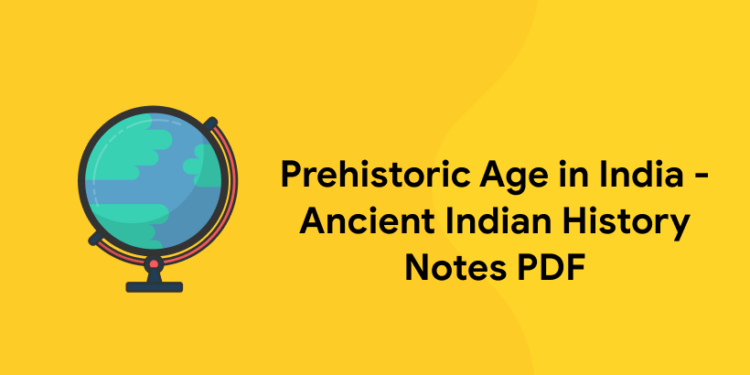Table of Contents
It’s easy to remember yesterday. The day before yesterday is also easy to remember. A year or few years back can also be remembered if we ask any person who lived at that time or refer to the books written at that time or photos taken at that time. Have you ever thought of knowing our past when there are no living persons from that time, no photograph taken at that time and no written records of that time? Well, the man of modern times has been searching for their past when there are no written records of the history. That time is called the Prehistoric age in India. The Prehistoric age is studied under the subset of ancient history, In Indian perspective ancient Indian history by the historians. Are you curious about what would be the culture, lifestyle, peculiarities of the prehistoric age in India? Apart from curiosity it would be helpful for those who study for UPSC, PSC and SSC examinations. Let us look into the peculiarities of the prehistoric age in India.
Why Should You Study Prehistoric Age History?
This would be a serious question by the history haters and those who get easily bored by the history study. Don’t consider it as an excuse to avoid ancient history studies but find it as fuel to enhance the need to study ancient history. Our past is something which will help us to leap forward. What was the culture of the primitive man? What was their lifestyle? How do they live? What mistakes do they commit? All these factors are analyzed. Maybe some of the ancient technologies and planning can inspire us or maybe the mistakes committed by them can lead us to the correct path. Thus, to study our past is to know ourselves. So, it’s important to study ancient history as well as the prehistoric age in India.
Prehistoric age in India classifications
1: Who was the first woman President of India?
The prehistoric age in India is classified into the following categories as
- Paleolithic Age (Stone Age)
- Mesolithic Age (Middle stone age)
- Neolithic Age (New Stone Age)
- Chalcolithic Age (Metal Age)
Register in to get the latest Exam Study Materials, PDFs, Video Lessons, Mock Tests! Limited Offer!
This age may seem like a chronological arrangement but actually it’s not. The period may nonuniform in different parts of the subcontinent. The period is measured scientifically using either of the two methodologies radio-carbon dating or dendro-chronology. Radio carbon methodology is based on the measurement of the loss of the carbon from organic materials over time and dendro-chronology is based on the measurement of rings of the woods of the tree. Even though both methodologies are helpful, radiocarbon dating is more popular.
Free UPSKILLING Courses!
Take your first step toward mastering in-demand skills, acing interviews, and securing top-tier jobs with Entri's free upskilling courses.
Start Learning!Comparison of Different ages in Prehistoric Age in India
| Paleolithic Age
|
Mesolithic Age | Neolithic Age
|
Chalcolithic Age
|
|
| The time Period
|
Before 10,000 BC
|
10,000 BC to 6000 BC | 6000 BC to 4000 BC | End of Second Millennium BC |
| Area which are Prominent | Soan valley and Potwar plateau of North West India,
Siwalik hills of north India, Bhimbetka in Madhya Pradesh, Admargah hills in Narmada valley, Kurnool in Andhra Pradesh, Attirampakkam near Chennai. |
Langanjh in Gujarat,
Adamgarh in Madhya Pradesh, Some places in Rajasthan, Bihar and Uttar Pradesh.
|
Maski,
Brahmagiri, Hallur, Kodakkal in Karnataka, Kashmir Valley, Chirand in Bihar, Belan Valley in Uttar Pradesh, Several places in Deccan.
|
The Harappan culture,
Valleys of Godavari, Krishna, Tungabhadra, pennar, Kaveri.
|
| Tools Used | Stone tools made of hard rock known as Quartzite
Large Pebbles |
Small stone tools called microliths
Use of bow and arrow was also there |
Stone tools are polished
Polished axes were found |
Tools made of bronze copper were used
|
| Mode of Living | Hunting large animals | Hunting small animals instead of large animals.
Domestication of animals, primitive cultivation and horticulture started. |
Practice of agriculture Domestication of animals Manufacture of pottery
|
Agriculture
Industry and craft Trade
|
| Cultural Characteristics
|
Only little knowledge about their language and communication
|
The paintings and engravings found at the rock shelter give ideas about social life.
|
Clothes used
Cattles used for cultivation and transport Village communities formed Mud brick houses were used |
Civilisations like Harappan civilization emerged
|
Prehistoric age in India – Harappan Civilization
When we discuss the major peculiarities and information regarding the different phases of the prehistoric age, the Harappan civilization deserves a special mention apart from the general description. Harappan civilization was one of the largest and oldest civilizations found in India (most of its territories are now in Pakistan) which give light to the Prehistoric age in India. It was also known as Indus valley civilization since most of it was found in the valleys of Indus and it is called Harappan civilization just because the first discovered site of it was Harappa.
Register in to get the latest Exam Study Materials, PDFs, Video Lessons, Mock Tests! Limited Offer!
Major Peculiarities and significance of the Harappan Civilizations were:
- The system of town planning (lines and grid system)
- Underground drainage system
- The Great Bath of Mohenjodaro (significance on rituals)
- Apart from copper and bronze gold and silver use was there
- Cosmetics and ornaments were in use
- Figures made of terracotta was found, Dancing girl (sculpture) throws light into art and culture
- Male deity was Pasupathi, female deity was Mother goddess, Linga worship was done, Trees and animals were also worshiped
- Post cremation and complete burial was also in popular practice
Conclusion
Studying the prehistoric age in India may be so dry. But to know how we have evolved and how our ancestors have lived is important in knowing ourselves. Even in the midst of all the wrongful practices they had, it is quite doubtful whether we have that kind of city planning and preparation even in the modern times. Apart from the self-satisfaction of knowing the prehistoric age in India is very essential for exams like UPSC Civil Services examination, PSC examinations and SSC examinations too. Crack the exams with Entri. Keep studying keep winning.












